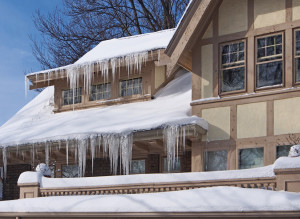What’s an ice dam? If you live in a cold part of the country, just pray you never find out.
Among the more damaging winter weather phenomena, ice dams are the wide ridges of thick, heavy ice that can form around the edges of a home’s roof during cold weather. If they get thick enough these ridges can prevent melting snow from draining off of the roof, building up the dam even further and potentially causing leaks and eventually damaging ceilings, walls and more.
You don’t want to be faced with an ice dam.
“Remember when snow was fun?,” writes the homeowners insurance company Travelers on its web site. “A day off from school. Building snow forts and snowmen. Now that you work, own a home or own a business, snow and ice may seem as though they are threatening your property and sense of well-being. Water damage, freezing and frozen pipes, and roofs damaged by ice dams are just a few things that can go wrong.”
Unfortunately, once a homeowner discovers an ice dam on their roof it is probably already too late for them. The damage has been done. So, the key is to prevent these ridges from forming in the first place.
Easier said than done.
The Beginning
First, understand how ice dams are formed.
- Warm air from inside the home collects in the attic and warms the roof.
- But if the eaves remain cold, as is common in most homes, water from the warm part of the roof can run off and freeze on the cold eaves.
- As ice builds up on the edges, a dam is formed. Further melting from the rest of the roof then backs up behind the dam, eventually working its way under the shingles and into the house.
Preventing Ice Dams
- Always remove excess snow from your roof: Clearing off the three to four feet of space at the edge of the roof after every storm will help prevent ice dams from forming by minimizing the heat differential between the eaves and the rest of the roof. Depending on the height of the home, this can be done with a roof rake.
- Keep downspouts clear in winter: By making sure the area around the downspouts is clear, you’ll prevent standing water from collecting near the base of the gutters. Over time, ice can work its way up blocked downspouts and contribute to roof ice formation.
- Maintain your attic insulation: A properly insulated attic helps to prevent the freeze-melt cycle that contributes to ice dam formation. Also make sure any spots where warm air might escape from your attic—vent pipes, exhaust fans, chimneys, etc—are sealed.
- Install a water-repellent membrane: A membrane installed under the roof’s shingles can act as an extra level of protection to keep seeping water out of the attic in the case of an ice dam. This can be done when replacing the entire roof to help minimize damage, but does little to prevent ice dams from forming.
How to Remove an Ice Dam
Once an ice dam has been discovered on a roof, there are pretty much only one thing that a homeowner can do: remove it.
- DIY: If the roof is accessible and can safely be reached during winter, the homeowner can try melting the ice dam themselves. One common recommendation is to fill a nylon stocking with calcium chloride ice melt—not rock salt, as that can damage the roof—and lay it across the dam so it melts a channel for the water to flow through.
- Call in the experts: If the roof is to high to reach safely, it’s time to hire a professional contractor to come out and remove the ice dam.


